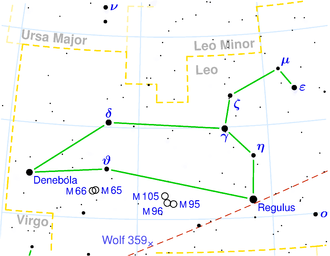NGC 3710
| Galaxie NGC 3710 | |
|---|---|
 | |
| SDSS-Aufnahme | |
| AladinLite | |
| Sternbild | Löwe |
| Position Äquinoktium: J2000.0, Epoche: J2000.0 | |
| Rektaszension | 11h 31m 06,9s[1] |
| Deklination | +22° 46′ 05″ [1] |
| Erscheinungsbild | |
| Morphologischer Typ | E / LINER [1][2] |
| Helligkeit (visuell) | 13,1 mag [2] |
| Helligkeit (B-Band) | 14,1 mag [2] |
| Winkelausdehnung | 1′ × 0,8′ [2] |
| Positionswinkel | 105° [2] |
| Flächenhelligkeit | 12,8 mag/arcmin² [2] |
| Physikalische Daten | |
| Rotverschiebung | 0.021648 ± 0.000103 [1] |
| Radialgeschwindigkeit | 6490 ± 31 km/s [1] |
| Hubbledistanz vrad / H0 | (288 ± 20) · 106 Lj (88,3 ± 6,2) Mpc [1] |
| Geschichte | |
| Entdeckung | William Herschel |
| Entdeckungsdatum | 10. April 1785 |
| Katalogbezeichnungen | |
| NGC 3710 • UGC 6504 • PGC 35502 • CGCG 126-078 • MCG +04-27-052 • 2MASX J11310694+2246046 • GC 2437 • H II 350 • h 904 • NSA 112792 | |
NGC 3710 ist eine elliptische Galaxie mit aktivem Galaxienkern vom Hubble-Typ E2 im Sternbild Löwe an der Ekliptik. Sie ist schätzungsweise 288 Mio. Lichtjahre von der Milchstraße entfernt und hat einen Durchmesser von etwa 85.000 Lj.
Das Objekt wurde am 10. April 1785 von Wilhelm Herschel entdeckt.[3]
Weblinks
Einzelnachweise
Auf dieser Seite verwendete Medien
Autor/Urheber: Sloan Digital Sky Survey, Lizenz: CC BY 4.0
The sky image is obtained by Sloan Digital Sky Survey, DR14 with SciServer.
Angle of view: 4' × 4' (0.3" per pixel), north is up.
Details on the image processing pipeline: https://www.sdss.org/dr14/imaging/jpg-images-on-skyserver/Autor/Urheber: Copyright © 2003 Torsten Bronger., Lizenz: CC BY-SA 3.0
This is a celestial map of the constellation Leo, the Lion.




